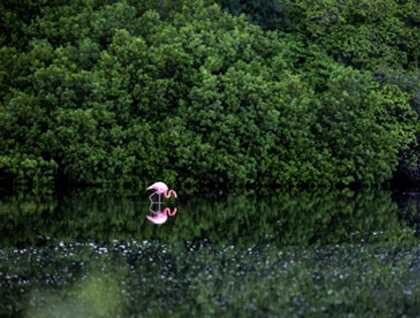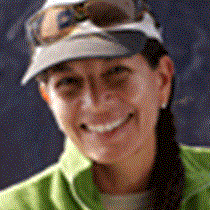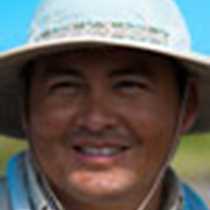Our visit started early this morning, before breakfast at Espumilla Beach, on Santiago Island. This beach is one of the archipelago’s most important marine turtle nesting areas, and we could see the evidence of sea turtles nests everywhere. A couple of Galapagos hawks were at the beach, right in front of the photographers, who enjoyed taking dozens of pictures of these "naïve" birds. Just behind the mangroves in a brackish lagoon, a solitary flamingo was feeding, and a loop trail leads took us inland over stony terrain, into the mature Palo Santo Forest, with a great view from the top of the trail at about a 45 ft elevation.
Santiago, also known as San Salvador or James, is the fourth largest of the Galápagos Islands, with a lush highland region and sources of fresh water inland. Due to this combination of features, Santiago Island was used by some of the very first human (and some non-human) visitors to Galápagos.
In 1997, Lindblad Expeditions “adopted” Santiago Island and created a special fund (now the Lindblad Expeditions-National Geographic Fund for Galápagos) to support one of the most major eradication efforts ever undertaken, to eliminate feral goats and pigs from the island.
Today, the goats and pigs are completely gone, but we still need to control the population of introduced rats and the parasitic fly “philornis downsi”, both of which are causing the decline of many species.
Once back on board and after a well-deserved breakfast, we spent time at a different location, the historic and scenic Buccaneer Cove, a one-time pirate haunt, as well as the original landing spot of Charles Darwin, when he visited the islands in 1835. He spent a total of five weeks in Galápagos, which included 19 days on land, of which nine were spent on Santiago.
We offered different rounds of glass-bottom boat outings and kayaking along the coastline. The deep-water snorkeling outing was excellent, because the temperature of the water was a little bit warmer than usual and the visibility was excellent. Hundreds of fish of different species where feeding near the surface, while young sea lions where playing here and there with our guests.
In the afternoon, and after my talk about Darwin’s exploration and research, we landed at Puerto Egas. Right at the landing site, we were all captivated by a tiny baby sea lion coming out of the water and searching for its mother, who was lying on the beach not far from the shore. The precious image and sounds of the baby interacting with the mother will create a lasting memory for our guests.
Most of our guests decided to stay at the beach and enjoy the water, while I took a group for a very relaxing nature walk along the shoreline, with dramatic tide pools and rocky formations where we found marine iguanas, sea lions, many coastal birds, some sea lions and at the end of the trail, in the deeply carved sea-level grottos, a small colony of fur seals.
We came back at sunset, with a better understanding of the serenity as well as the fragility of this unique archipelago.









